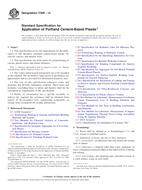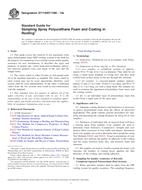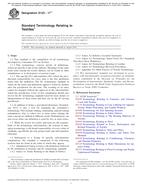1.1 These test methods cover the determination of trace (μg/L) levels of fluoride, acetate, formate, chloride, phosphate, and sulfate in high purity water using ion chromatography in combination with sample preconcentration. Other anions, such as bromide, nitrite, nitrate, sulfite, and iodide can be determined by this method. However, since they are rarely present in significant concentrations in high purity water, they are not included in this test method. Two test methods are presented and their ranges of application, as determined by a collaborative study, are as follows:
| Range Tested (μg/L Added) |
Limit of DetectionA (Single Operator) (μg/L) |
Sections | |
| Test Method A: | 7–15 | ||
| Chloride | 0–24 | 0.8 | |
| Phosphate | 0–39 | B | |
| Sulfate | 0–55 | 1.8 | |
| Test Method B: | 16–23 | ||
| Fluoride | 0–14 | 0.7 | |
| Acetate | 0–414 | 6.8 | |
| Formate | 0–346 | 5.6 |
A Limit of detection is lowest measurable concentration not reportable as zero at 99 % level of confidence as per EPRI study as cited in Sections 15 and 23.
B Insufficient data to calculate limit of detection.
1.2 It is the user’s responsibility to ensure the validity of these test methods for waters of untested matrices.
1.3 The common practical range of Test Method A is as follows: chloride, 1 to 100 μg/L, phosphate, 3 to 100 μg/L, and sulfate, 2 to 100 μg/L.
1.4 The common practical range of Test Method B is as follows: fluoride, 1 to 100 μg/L, acetate, 10 to 200 μg/L, and formate, 5 to 200 μg/L.
1.5 The values stated in SI units are to be regarded as standard. No other units of measurement are included in this standard.
1.6 This standard does not purport to address all of the safety concerns, if any, associated with its use. It is the responsibility of the user of this standard to establish appropriate safety and health practices and determine the applicability of regulatory limitations prior to use.
7.1 This test method is optimized for the quantitative determination of trace levels of chloride, phosphate, and sulfate. Anions such as fluoride, acetate, and formate can be detected by this method, but are not reliably resolved from each other. See Fig. 1 for a typical chromatogram.
7.2 Using a concentrated sample volume of 20 mL, the test method is applicable in the range outlined in Section 1. The range of this test method may be extended by concentrating a smaller or a larger sample volume. Be sure not to exceed concentrator column breakthrough volume (see annex).
16.1 This test method is optimized for the quantitative determination of trace levels of fluoride, acetate, and formate in high purity water and in water containing up to 2000 mg/L boron from boric acid. The range of the method is summarized in Section 1. See Fig. 3 for a typical chromatogram.
16.2 This test method does not respond to sulfate, since its elution time is very long.
16.3 Using a concentrated sample volume of 20 mL, the test method is applicable in the range outlined in Section 1. The range of this method may be extended upward by concentrating a smaller sample volume, or downward by concentrating a larger sample volume. When analyzing samples containing high amounts of boric acid (for example, 1 %), the volume concentrated should not exceed 30 mL, so as not to exceed the breakthrough volume for fluoride.

FIG. 3 Anions by Test Method B
Product Details
- Published:
- 05/01/2009
- Number of Pages:
- 9
- File Size:
- 1 file , 150 KB
- Redline File Size:
- 2 files , 270 KB


